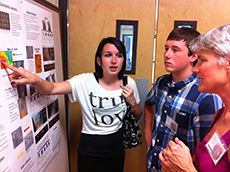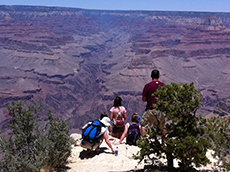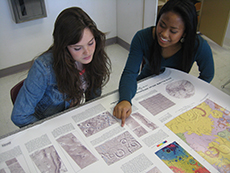Media Contacts:
Geoffrey Brown, Johns Hopkins Applied Physics Laboratory
(240) 228-5618 or (443) 778-5618
geoffrey.brown@jhuapl.edu
March 5, 2013
Students Make Real Contributions to Martian Science with CRISM Data
In classrooms across the country, high school and college students are helping scientists to analyze CRISM images through the Mars Exploration Student Data Teams (MESDT) program. By sifting through authentic data and making presentations on their findings, the students are getting a taste of true scientific work.

Click on image to enlarge.
Students present their posters to planetary scientists at the 2012 USGS Planetary Mappers Meeting in Arizona.
Credit: JHUAPL
MESDT began in 2005 “as a way to include students in the scientific process similar to what research scientists were doing,” says program coordinator Brian Grigsby.
“They’re doing authentic work,” says Dawn Turney, CRISM’s Education and Public Outreach Specialist. “It’s not contrived assignments. Some of the data hasn’t been examined in detail until now.”
The hands-on exposure to science is also meant to encourage students to pursue science, technology, engineering and mathematic (STEM) careers. Rick Snyder, a teacher who leads the student data team at Kickapoo High School in from Springfield, Mo., says that the program provides excellent real-life applications of the concepts he teaches in his Earth Science and Astronomy classes. “The MESDT program has provided an avenue for many of my students to analyze real-time data and conduct authentic scientific research projects related to the geology and geologic history of Mars,” he says.
Using online conferencing technologies, mentors from CRISM’s science team instruct students on topics like geologic principles and spectroscopy, and teach them to work with the data. Students then design and carry out original research projects in their classroom and present their findings to the science team and other student teams.
Experiencing another aspect of a scientist's work, some MESDT team members have presented posters at the Lunar and Planetary Sciences Conference near Houston, Texas in past years. In addition to showcasing their work, the conference allowed students to meet their mentors and other students face-to-face.
Last June, two MESDT teams won scholarships from the CRISM Science Team to participate in the USGS Planetary Mappers Meeting in Flagstaff, Ariz. The trip allowed the students to present their work and hear the critiques of planetary scientists from across the country.

Click on image to enlarge.
MESDT teams took a geology field trip to the Grand Canyon when they were on the scholarship trip to the 2012 USGS Planetary Mappers Meeting.
Credit: JHUAPL
While there are usually five to ten teams participating each year, the 2012-2013 school year saw a large jump in applications. “The excitement of the Curiosity rover had a lot to do with it,” Grigsby explains. “Especially since the CRISM instrument and the Mars Reconnaissance Orbiter helped with the landing site selection, we were able to help students understand the importance of exploring the surface with orbital instruments.”
In the years leading up to the Curiosity landing, students were conducting their own research on where they might select as its landing site based on the same parameters given to scientists. Once the rover landed in Aug. 2012, students could then follow Curiosity’s exploration of the surface of Mars.
MESDT has proven itself a success with the stories of how it has impacted lives. Teachers have commented on the fact that some “at-risk” students have dramatically turned their focus on academics around because of the program. And some kids, who had previously never dreamed of pursuing very ambitious career paths or going to college, now believe they can and will become scientists.
MESDT successfully exposes students to STEM careers and a number of students have gone on to study STEM fields in colleges. As one teacher put it, “New found love of science and has provided a ‘career compass,’ as many former participants of MESDT are now pursuing careers in geological, meteorological, science and technology careers.”
- Lydia Zuraw
The Applied Physics Laboratory, a not-for-profit division of The Johns Hopkins University, meets critical national challenges through the innovative application of science and technology. For more information, visit www.jhuapl.edu.

